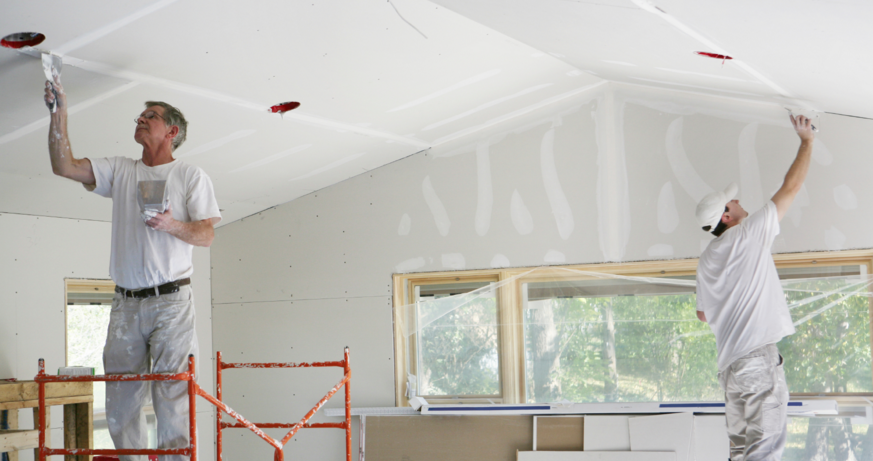Drywall Repair Las Vegas involves fixing imperfections like small dents or cracks on the walls. Most of these can be filled in with spackle or joint compound, smoothed and then sanded down to achieve a seamless appearance.
To accomplish this task, you will need a utility knife, paper tape and joint compound. Remember to be careful not to nick any electrical wires or plumbing.

A few minor drywall problems are easy enough to tackle on your own, but many homeowners will need to hire a drywall contractor for major repairs. This may be because of a recurring problem that can’t be easily solved, the need to take care of multiple rooms of damage before selling the house, or just the fact that a professional will have the tools and materials needed to make a quick and efficient repair.
Superficial drywall damage, such as small dents and hairline cracks can often be repaired with spackle. Similarly, nail holes or other holes in drywall can be filled with mud and sanded smooth before painting. The amount of time this takes and the cost of the mud will depend on the extent of the hole.
If the damage to your drywall is caused by water, it can be more difficult to patch and will likely require the replacement of that section. Whether this is because of a leak in your roof or plumbing, or it’s the result of a flood from a burst pipe, water damage can quickly lead to discoloration, mold growth, and other serious structural issues that only a professional will be able to address.
It’s important to get water damaged drywall repaired as soon as possible. A drywall that’s damp will look discolored or will have a musty smell that indicates the presence of hidden mold. A professional will be able to use moisture testing equipment to determine the extent of the water damage and can recommend repairs that will restore the integrity of your drywall.
Drywall that has been affected by water can also become brittle over time and may need to be replaced. A drywall contractor will be able to determine the extent of the water damage and the best way to replace it.
A drywall repair and painting company will typically charge for their services by the job rather than by the hour. They will also be able to give homeowners a clear idea of how long the project will take and what the estimated costs will be before starting work. This will be particularly helpful when it comes to budgeting for the work as homeowners can plan ahead for unforeseen expenses that could arise.
Drywall Patching
The simplest solution for fixing holes in drywall is to use a patch. You can cut a custom patch from another piece of drywall or you can buy one that is pre-cut. For most DIY repairs, the latter is preferred because it makes the repair much faster and simpler. It is important to make sure that the drywall patch fits properly before installing it. If it is too loose or tight, it will crack and may require reworking. A framing square and pencil will be helpful for locating cutting lines. A utility knife can be used to trim any places that aren’t a perfect fit, but try to avoid forcing the patch into place because this will cause it to crack.
When using a patch, it is essential to secure it to the wall with drywall screws. Ideally, the screws should be placed in studs if possible to prevent the patch from pulling away over time. It is also a good idea to countersink the screws so that the heads are below the surface of the drywall. This will help to prevent the drywall patch from becoming unsightly in the future and will also allow for easier cleaning.
Drywall patching can be a tricky task, but it is relatively easy if you follow the proper steps. It is recommended that you only attempt to patch holes in drywall that are less than 10 inches wide. A patch kit will typically include wood backing strips and drywall screws to secure the new patch. Before putting the patch in place, it is important to check that all of the seams are taped and covered with joint compound (also known as “mud”).
It is also necessary to prepare the surface of the hole before applying the patch. This will help to ensure that the adhesive patch sticks properly and that it is easy to smooth with a putty knife. This step will generally involve sanding the surface of the hole and wiping it down to remove any dust or dirt that might be present.
Once the sanding and smoothing is complete, the patch can be painted to match the rest of the wall. It is recommended that you use a primer when painting the patch, so it does not absorb the color of the surrounding paint. In some cases, especially if the damaged area is very large, it may be best to repaint the entire wall rather than attempt to touch up the damage.
Drywall Replacement
When drywall is sagging, water damaged or moldy, it’s often best to replace the entire section rather than try to patch it. This is also true for large holes in a wall where you have to worry about electrical wires and plumbing. It’s a bigger job and requires more expertise, but it’s still within the scope of most homeowners who have a good tool kit and some patience.
The first step is to remove any loose insulation from around the hole and sweep away any debris or dirt. You can also use a stud finder and carpenter’s square to outline the area that needs to be removed. It’s important to keep in mind that if you do this, there may be plumbing and electrical wiring running behind the drywall, so it’s important to check before you cut!
Once the area is cleared, it’s time to prep the wall for a new patch. Start by wiping down the entire surface to make sure there’s no dust or wood shavings that could interfere with the adhesive on your patch. You’ll also want to ensure that the patch you’re using is the same thickness as the surrounding drywall, or it won’t blend in properly.
Next, you’ll need to apply a thin coat of joint compound over the area and let it dry completely. Once it has, sand it down until you have a smooth surface. Then, repeat the process until you have a surface that is ready for a fresh coat of paint.
If you’re worried about doing the drywall replacement yourself, you can always hire a professional for a more involved repair job. For example, if you have to replace an entire section due to extensive damage, or if you’re concerned about electrical wires or plumbing, it’s usually best to leave the job to a professional.
The most common cause of drywall damage is moisture. If you have a problem with sagging, warped, moldy or wet drywall, it’s likely because of a leak in the ceiling above. This can be a result of roof problems, or it can be caused by the plumbing in your home.
Drywall Repair Companies
Drywall is an important part of your home, and it needs to be in good condition to maintain the value of your property. A company that offers drywall repair will have the knowledge and tools needed to fix your walls properly, making them attractive and ready for repainting. A reputable drywall company will also be insured and bonded. This will protect you in the event of an accident while the work is being performed.
The most common drywall repair is the patching of small holes. These can be caused by many different things. A nail that hits the drywall, removal damage, or moisture damage are some of the most common causes. If the hole is large it may need to be cut out and replaced.
For smaller holes a drywall patch is the most efficient way to fix it. These are available in a variety of sizes and can be purchased at any hardware store or big box retailer. The first step is to clean the hole of any loose debris and make it as smooth as possible. You should also put on a dust mask to protect yourself from inhaling the dust particles. Next, you need to prepare the area for the drywall patch. This includes applying joint tape around the perimeter of the hole or crack to keep water and dust from seeping into the drywall and to help hold the patch in place. Finally, you need to sand down the patch area to make it smooth and even with the surrounding wall surface.
Another common drywall repair is fixing dents. These can be caused by a number of things including running into a wall with the vacuum cleaner, someone flinging a toy at the wall, or a rambunctious child trying to hang a picture. Once the dents are repaired with spackle, it is possible to repaint over them without the problem being noticeable.
While it is possible to do some drywall repairs yourself, hiring a professional is usually the best option. It takes years of training to become a qualified expert in drywalling. It is a very difficult job that requires precision and attention to detail.
